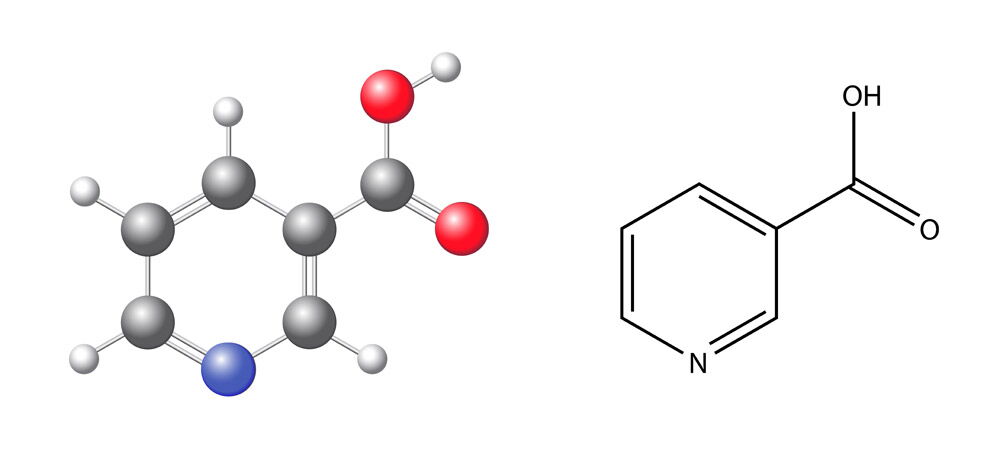The term niacin (Acidum nicotinicum; vitamin PP, from Pellagra Preventis or vitamin B3) includes pyridyl-β-carboxylic acid (nicotinic acid) and its derivatives, which have the same biological activity as nicotinamide.
Nicotinic acid is found in plants, and nicotinamide can be detected in animal tissues. There are various dietary sources of niacin, however good carriers are: cereals, especially unrefined, dried legumes, meat, eggs, fish products and offal.
Nicotinic acid in tissues can be synthesised from tryptophan, an essential amino acid (strictly introduced through the diet), via the kynurenines and quinolinic acid routes. (Even the intestinal bacteria can contribute to this metabolic conversion process, by metabolising tryptophan).
The convertible niacin in tryptophan is 60 mg to obtain 1 mg of nicotinic acid. This may partly compensate for low levels of vitamin PP consumption, although it does not seem sufficient to completely eliminate this compound from the diet.
Nicotinic acid and nicotinamide are absorbed in the stomach and intestines via 2 methods, depending on their concentrations:
-
by a facilitated, sodium-dependent transport mechanism, in the case of low concentrationss of vitamin
-
by a passive mechanism,where there are higher amounts. In the body, nicotinic acid is converted to nicotinamide. In the liver, both compounds are metabolised to pyridone (N-methyl-2-pyridone-5-carboxamide) and N-methyl-nicotinamide, which are then excreted in urine.

Biologically active forms of niacin
Niacin has 2 biologically active forms, which both act as co-enzymes:
1 - Nicotinamide adenine dinucleotide (NAD)
NAD is synthesised in the body via three different pathways involving, respectively, nicotinic acid, nicotinamide and quinolinic acid
2 - Nicotinamide adenine dinucleotide phosphate (NADP)
NADP is obtained by bonding between a phosphate group and the OH group of NAD.
Both NAD and NADP are involved in multiple redox reactions, belonging to both catabolic and anabolic routes that, with a role as acceptors ofa hydride ion (H-), which is derived from processes catalysed by a particular class of enzymes called pyridinic dehydrogenases.
The hydride ion is positioned at C4 of the nicotinamide. Because these reactions are reversible and pH dependent, it follows that NADH and NADPH can be oxidised depending on requirements.
A deficiency of vitamin PP occurs in people who consume insufficient amounts of it or too little tryptophan. Pellagra is a manifestation of insufficient niacin intake, and is distinguished initially be gastrointestinal problems to which a photosensitising dermatitis may also be added. They also usually have mental disorders, with fatigue, depression and memory impairment.
Given that tryptophan can act as a precursor of nicotinic acid, it is usual to assess the need for both, and this is expressed in the form of a Niacin requirement.
Recommended dosage:
Generally, the recommended dose is 13 mg for an adult eating about 2,000 kcal, and 20 mg for an adult who consumes around 3,000 kcal. Consumption of high doses of nicotinic acid (1.5-3 g / day) can reduce levels of LDL cholesterol and plasma triglycerides (for inhibiting hepatic lipolysis) and at the same time, raise HDL cholesterol levels.
The main side effects (some of which are sought after by bodybuilders) that can occur with vasodilators are flushing, erythema, pruritus, epigastric pain, nausea, headache and diarrhoea (obviously body builders are seeking the vasodilatory effect).
My experience with this supplement leads me to say you should use it about 30 minutes before a workout, and try to see what the suitable dosage is in a very subjective way; its difficult to find in tablets with a lower titration than 50 mg, therefore starting with this is the the most obvious choice, then try every 4-5 days (even every week) to increase by 50 mg (remember that the absorbtion of artificially produced vitamins is reduced compared to those in food), and carrying on until you find a dose that allows you to fully exploit the pump due to Niacin, which should result in no side effects (personally, I was fine with 150 mg, but that does not mean that 50 mg could be too much for you).
I repeat, these are only recommendations I have given you, and it is always good before using certain types of supplements to consult a professional who is a doctor or a nutritionist.
